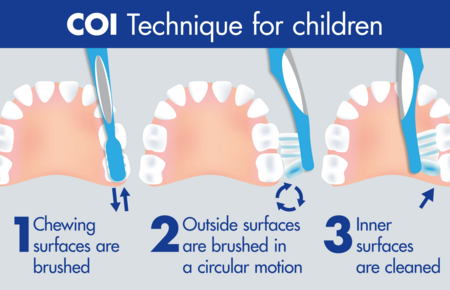Brushing teeth with babies: What brushing technique should I use?

Brushing teeth with children is not always easy. They often get bored of brushing after a while or chew on their brush. The toothpaste is also often spat out because it does not taste good or all of it is simply swallowed.
However, regular dental care is very important, right from the very first tooth. This is because the milk teeth fulfil many important functions and are necessary e.g. for chewing and learning to talk, as well as in their role as placeholders for the permanent teeth. They should be well protected.
Brushing teeth for children made easy: the COI technique

The right dental care for children starts from the very first tooth. The earlier parents get their children used to a toothbrush, the more natural the daily ritual. Young children are not able to thoroughly brush all teeth themselves, even if they insist they are. This is why parents should definitely brush again. Children often only manage to brush their teeth without any help when they can write properly. But how does your child brush their teeth properly?
When you first visit the dentist, the so-called COI brushing technique is often recommended. COI stands for Chewing surfaces, Outside surfaces, Inside surfaces. Children can remember this technique well. First the chewing surfaces are brushed with brief forwards and backwards motions, then the outside surfaces are brushed with small circular motions, followed finally by the inside surfaces of the teeth from red (gums) to white (tooth). This process is repeated in the mornings and evenings for at least two minutes – then the teeth are often brushed well enough by this point. These three further rules are additionally helpful for good dental care:
- The two minute rule: According to dentists, two minutes offer the optimum brushing time. In this respect, a specific pattern for brushing should be followed so that the brushing time per tooth remains the same.
- Do not apply too much pressure when brushing: Children should not brush their teeth too hard. The gums as well as the enamel are sensitive and could be damaged. It is advisable for children to use a soft to medium hard brush.
- Changing toothbrushes regularly: It is important to regularly change the toothbrush. A good rhythm to follow is changing the brush every six to eight weeks – at the latest when the bristles point to the sides. Furthermore, every family member should have their own toothbrush or own brush head!
Brushing teeth for small children – finding the right toothbrush
The question of finding the right toothbrush for children is on the minds of many parents. The following tips should be observed: Use a soft or medium hard children's toothbrush with rounded plastic bristles, a small brush head and a non-slip handle. They are available in various sizes depending on the age of the child. As soon as the bristles start bending outwards, it is time for a new brush. Toothbrushes should generally be changed every six to eight weeks. Special electric toothbrushes for children are also recommended. These are also available for children in smaller and colourful models. Especially for children who don't like brushing their teeth, an electric toothbrush can offer a new attraction.
Tip: Let your child choose their own toothbrush and then they will also prefer to use it.
The right toothpaste for children

In Germany, almost half of all children in their first year at school suffer or have suffered from caries. Children have an increased risk of developing caries because they do not yet have the motor skills to brush their teeth as well as adults can. In addition, they love eating many foods that are unhealthy for their teeth. However, the high proportion of caries in milk teeth is not necessarily related to inadequate dental care. Whilst many children's toothpastes use fluoride (exogenous) for caries prophylaxis, Kinder Karex uses the tooth-like active ingredient BioHAP (biomimetic hydroxyapatite). Recent (long-term) scientific studies confirm that primary teeth are protected from caries by BioHAP and fluoride in equal measure. The advantage of BioHAP: There is absolutely no risk whatsoever of fluorosis (discoloration of the remaining dentition) if the toothpaste is swallowed. Toothpastes with the active ingredient BioHAP offer an effective alternative here. BioHAP – the substance from which our teeth are made – effectively protects against caries and is not hazardous to health when swallowed because it simply dissolves in the stomach. Kinder Karex Toothpaste uses this alternative active ingredient and is suitable for all age groups from 0 – 12 years.
Click on the link for more information about caries in children.
Tips for dental care in children
For children who refuse to brush their teeth, this task is often not easy. Prevent caries and help your child with these tricks for dental care:
- As soon as the first tooth appears, brush teeth every day, particularly after the last meal before bedtime
- Right position: It is best to brush babies' teeth on the changing table and when they get older they can sit on your lap
- Be a role model: Let your child watch when you brush your teeth or brush your teeth together.
- Only drink water or unsweetened tea in the evening after brushing
- Brushing again by an adult until the child reaches primary school. Rule of thumb: Keep brushing again until your child has mastered writing
- Pay increased attention to the molars, which come through at around the age of 6. They are particularly susceptible.
- Visit the dentist annually as soon as the first tooth appears
- A toothbrush chosen by the child itself will more likely be used
We have summarised more information on how to encourage children to brush their teeth in our tricks on motivating to brush.






